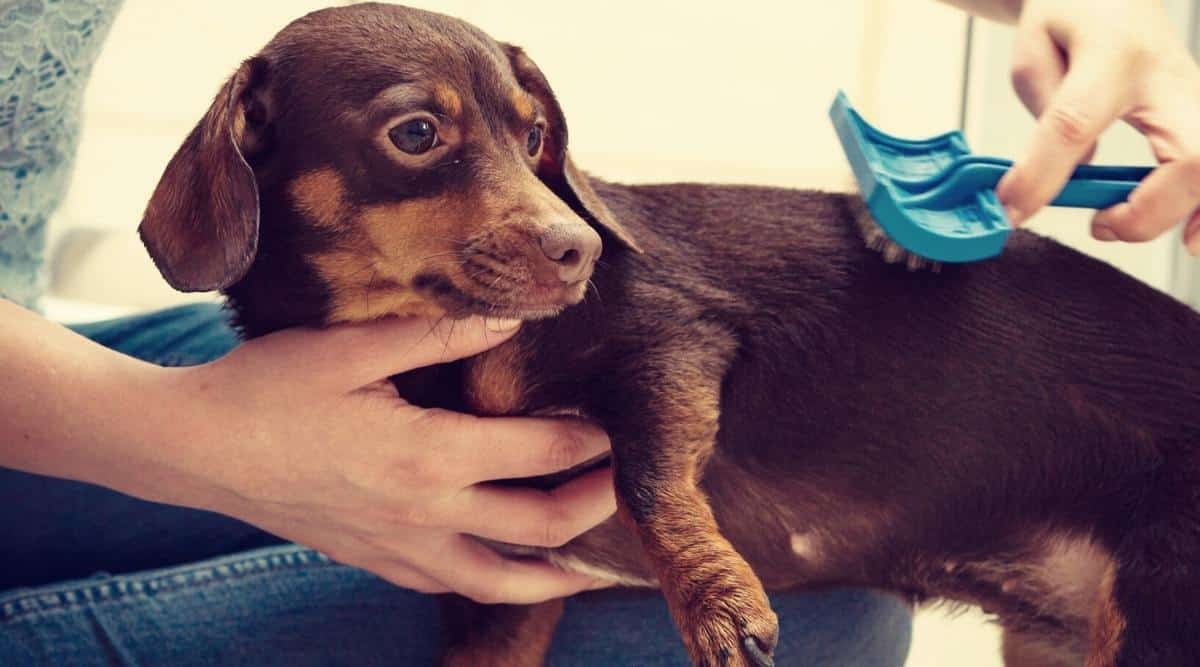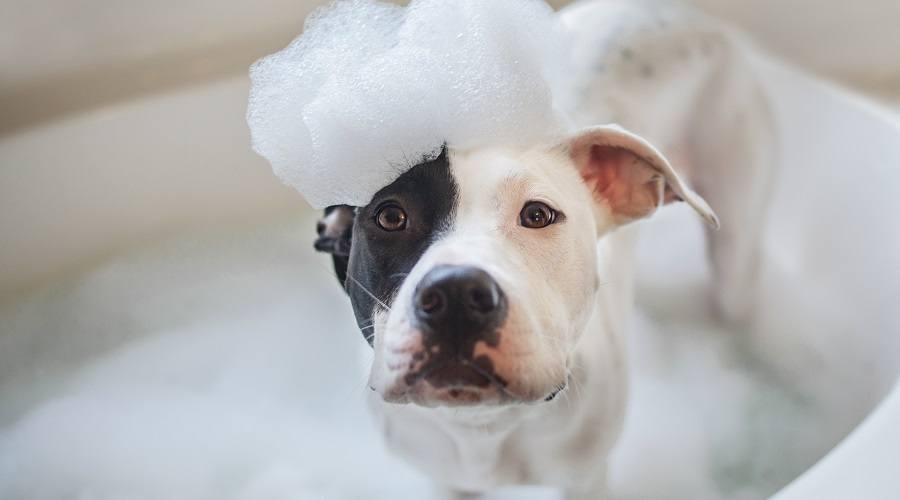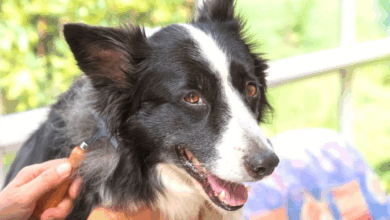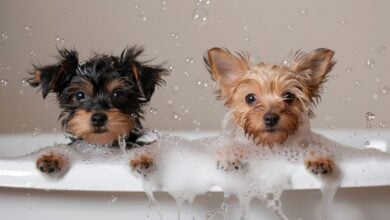Shih Tzu Shedding: How Much Do Shih Tzus Actually Shed?
When you purchase through links on our site, we may earn a commission. Here’s how it works.
If you’ve been dreaming of a Shih Tzu but are concerned about how much they shed, the first thing to consider is that just because a dog has long hair doesn’t mean it has to leave a lot of hair behind. The grooming and daily care you’re willing to put in make a big difference in overall shedding.
Table of Contents
Created as a palace companion, your Shih Tzu’s regal coat is his crowning glory, but he’s never too staid to play. Fans of the breed describe his personality as “affectionate, playful, and outgoing.” Shih Tzus are moderate shedders overall, but their shedding varies by season.
Whether there’s a member of your household with a dog allergy or you’re just trying to make sure you can manage his grooming, consider how much work you’re willing to put into your Shih Tzu’s coat before you make that leap to purchase. Learn what you’ll need to do to minimize shedding to make your match a success.
At A Glance: Best Products For Boxer Grooming
Shih Tzu Coats
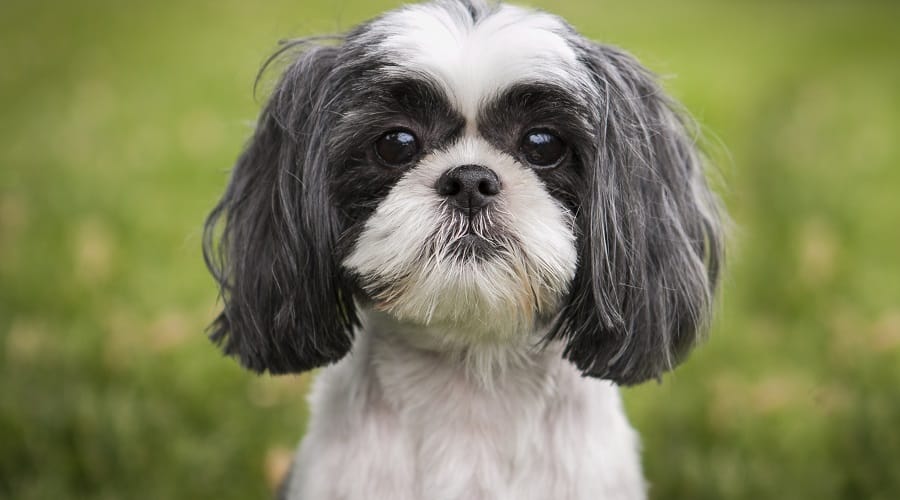
Shih Tzus have hair that is different from a short-haired dog. They are sometimes called chrysanthemum dogs because of the way their hair grows on their faces. Their faces require daily care to look their best. Gently clean the corner of the eyes with a damp cloth. Brush their mustache and topknot daily to remove debris or food particles.
Shih Tzus have double coats. Their long, hard outer coat covers a soft undercoat that insulates them in summer and winter. When they do shed, the hair gets trapped in their outer coat, and you can brush it out. A double coat does best with daily brushing. Shih Tzus need their eyes and mustaches cleaned daily. To protect the Shih Tzu’s eyes from being irritated, the hair on the top of the head should be trimmed short or tied up into a topknot. Trimming nails and cleaning ears should be part of your Shih Tzu’s grooming routine.
Shih Tzu Colors
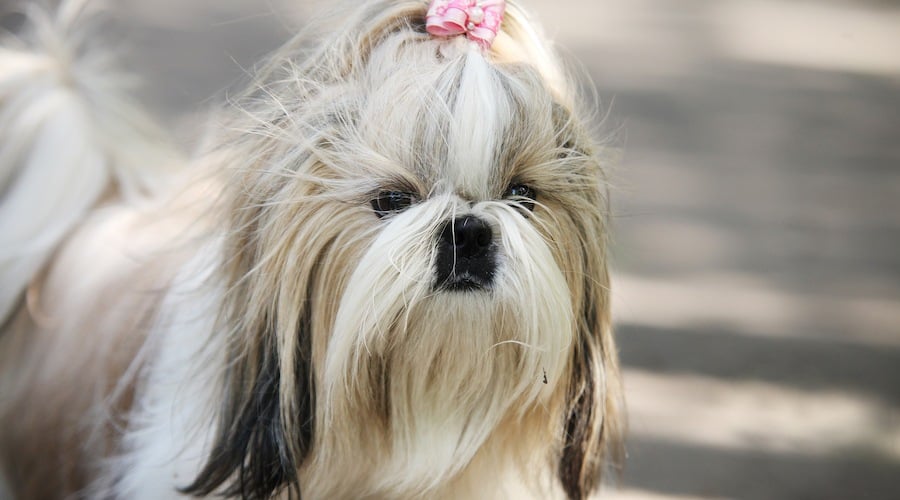
Color, of course, is a matter of personal preference and does not change how much your pup sheds. Keep in mind you may notice the hairs shed by a black dog on your light-colored clothing more than you will the hairs shed by a lighter-colored dog. Standard breed colors include black, blue, brindle, gold, liver, red, silver, and any of these colors and white.
Shih Tzu Shedding Frequency
Because Shih Tzus are double-coated dogs, you may only notice when they shed their undercoat in spring and fall. This dense undercoat keeps them warm in cold weather, but they will shed it twice a year. When their undercoat sheds out, they will quickly lose a large amount of hair. Brushing out their undercoat can shorten the duration of their shedding season.
If your pup seems to shed more than you like, you may need to change your grooming routine. Regular brushing and bathing remove hair that would usually be left behind and minimizes what ends up in your home. You may opt to have his hair trimmed short in a puppy cut to lessen the amount of hair he leaves behind.
Hypoallergenic Dogs
You may have heard that some breeds are hypoallergenic during your quest to find a new buddy to add to your family. If a household member may have pet allergies, this sounds particularly desirable. The proteins in your pet’s urine, saliva, or dead skin cells (known as dander), may cause people with pet allergies to have itchy, watery eyes or a stuffy nose. People with more pronounced sensitivities can have symptoms as severe as shortness of breath within fifteen to thirty minutes of inhaling these allergens. Sensitive people may also develop a rash on their face, neck, and upper chest.
If you have a family member who is allergic to pet dander, you want to find a breed with hair that won’t create health problems for your human family or a situation where you must rehome your pup. Shih Tzus do shed and are therefore not considered hypoallergenic, but they shed minimally, making their shedding manageable. Whether or not this will work in your situation is something you must address frankly before welcoming home your new pup. Remember that any dog, unless it is hairless, will shed and have dander.
Other Reasons For Losing Hair
Skin Conditions
Although shedding is normal, abnormal shedding can indicate a health problem. Sometimes excessive shedding originates in the skin, also known as the dermis. Inflammation of the skin is called dermatitis (dermis=skin itis=inflammation) and can have a root cause that is either internal or external in origin.
Some breeds of dogs are more prone to specific skin problems than others. If your dog seems to be shedding more than usual and shows patches of severe hair loss (alopecia), you need to examine the skin beneath the hair. In some cases, dogs may have hormonal or autoimmune disorders that cause dermatitis and hair loss. Aging can exacerbate these conditions.
If you notice that your pup’s skin seems thicker than usual and excessively oily or greasy, has become scaly or red, or has an unhealthy odor, schedule a consultation with your veterinarian. Your dog could suffer from a treatable condition that will respond to vitamin or mineral supplementation or a specific care regimen.
Flea Allergy
Several external causes of hair loss strike all dogs, regardless of breed. Dogs can be allergic to flea bites. Other parasitic causes of hair loss include sarcoptic or demodectic mange. Both fungal and bacterial infections of the skin can cause excessive shedding. If you know you have a flea problem, putting together an effective flea management regimen is the first line of defense, but if your buddy is still itchy after the fleas are gone, a visit with your vet is in order. They may perform a “skin scrape” and examine the sample under a microscope to decide the proper course of treatment.
Food Allergies
Your dog’s food sensitivities can cause itching to the point of hair loss. Food sensitivities are tough to diagnose. An at-home allergy test from EasyDNA may help you learn more.
If you suspect your kibble is the source of your dog’s excessive itching and shedding, you might try a special diet with ingredients formulated not to trigger allergic reactions. Ask your vet what brands and formulas they recommend. You should be able to find a blend that keeps your buddy healthy and happy at a comfortable price point.
Managing Shih Tzu’s Shedding
Shih Tzus don’t shed much except when they shift from one season to the next. How you groom or trim their coat makes a big difference in how much hair they lose around the house. Giving your pup the best diet possible for his size and age helps keep his skin and coat healthy from the inside out. You can’t eliminate shedding completely, but you can make a difference.
Brushing
When your Shih Tzu is shedding his undercoat, the hair he sheds falls back into his coat. Brushing it removes it, making it less likely to end up on you or your furniture. During this high shedding period, he’ll benefit from an undercoat rake. Regular brushing stimulates blood circulation and distributes oils throughout his hair so that his coat glows with health.
If you keep your Shih Tzu’s hair long, he will have tangles. Tangles typically form in the armpits, inside the legs, and behind his ears. Shih Tzu puppies begin to tangle around eight to ten months of age. As his haircoat transitions from puppy to adult hair, the tangles will diminish by about two years, depending on his hair’s quality and amount. Use a detangling spritz and carefully comb the knots while holding the hair next to your pup’s skin so it doesn’t pull. Your pup’s skin will be tender, so work slowly.
Types Of Brushes
Choose your grooming tools with care. Use a wire brush with flexible pins or an undercoat rake to gently work the loose hair out from that bottom layer. Brushing after a bath or using a spritz will help remove loose hair, help with tangles, and keep his coat clean longer. Remember to comb the mustache and topknot daily and gently clean the corner of the eyes with a damp cloth. A fine-toothed comb works both for his mustache and gently combing around his eyes. Specially designed wipes help keep stains from forming around his eyes.
Shampoo
Always choose a dog-safe shampoo. If your pup’s skin is sensitive, choose a shampoo specifically formulated for sensitive skin. Even with a gentle shampoo, shampooing him too frequently can strip the natural oils from his coat and dry his skin. Limit baths to once every few months. It’s easiest to get all the loose fur out of your Shih Tzu’s coat while he’s still damp.
Diet
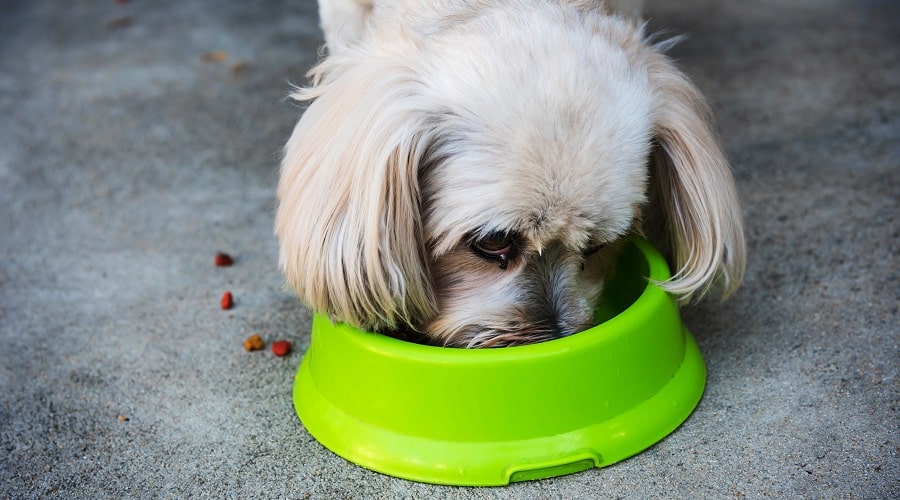
Feeding dog food that does not contain known allergens is the first building block of coat health. Many dogs are allergic to chicken in commercial dog foods. If you’re worried your pup may have a food sensitivity, try a chicken-free formula.
Nutritional deficiencies from lower-quality dog foods can also cause dermatitis and excessive shedding. Finding a quality food with ingredients your particular dog can tolerate may take a bit of leg work up front, but in the long run, it will save you money in additional supplements and vet bills. More importantly, it will save your best friend unnecessary discomfort and optimize his health.
The brand you choose should include omega-3 fatty acids. Omega-3 fatty acids have anti-inflammatory properties considered beneficial for dogs’ skin and coats. Research has shown that omega-3s have health benefits for dogs beyond just making their coats shine. They reduce inflammation in the body, keeping your buddy more comfortable and keeping itchy skin at bay.
Supplements
Omega-3 supplements and treats make adding more omega fats into your buddy’s diet easy. Fish oils add omega-3s to promote a healthy coat and reduce shedding. Some supplements contain a blend of fish and plant-based oils to provide a balanced ratio of the three main types of omega-3 fatty acids, alpha-linolenic acid (ALA), eicosapentaenoic acid (EPA), and docosahexaenoic acid (DHA).
Air Purification
You can minimize how much your Shih Tzu sheds with good nutrition and frequent grooming, but you can’t stop him from shedding. Adding air purification to your home has benefits beyond tackling dog hair, but it’s one more way to reduce the amount of hair in your home and the allergens in the air. The most significant allergen dogs introduce is dander, the dead skin cells constantly sloughing and falling along with shed hairs.
Dog dander is roughly 2.5 microns, although it may be larger. An air purifier that effectively eliminates airborne particulates smaller than this can significantly reduce the amount of pet dander available to trigger allergic symptoms. The Filtrete Air PurifierFAP-C03BA-G2 claims to capture 99.97% of airborne particles (as small as 0.3 microns), including dust, lint, dust mite debris, and mold spores, pollen, pet dander, smoke, smog, bacteria, viruses, exhaust particles, and ultrafine particles.
Vacuuming
While vacuuming is nothing fun, it is one more tool in the arsenal against pet hair. If your air purifier eliminates the airborne particulates that trigger your allergies, a mechanical vacuum can take care of anything that lands on surfaces in your home or car. The best vacuum is lightweight, so you’ll use it frequently and versatile enough to tackle multiple surfaces in your home and elsewhere.
While it is a traditional handheld stick vacuum, the Bissell Featherweight Cordless XRT also includes specialized pet tools. It converts to a handheld vacuum with a crevice tool and upholstery brush to get pet hair wherever it settles. This lightweight vacuum handles hard surfaces and area rugs but may not have the power for a home with wall-to-wall carpets. Carpet is a significant factor in how much hair and dander stay trapped in a room. You may consider the more powerful Bissell ICONPet Edge for fully carpeted homes.
Frequently Asked Questions
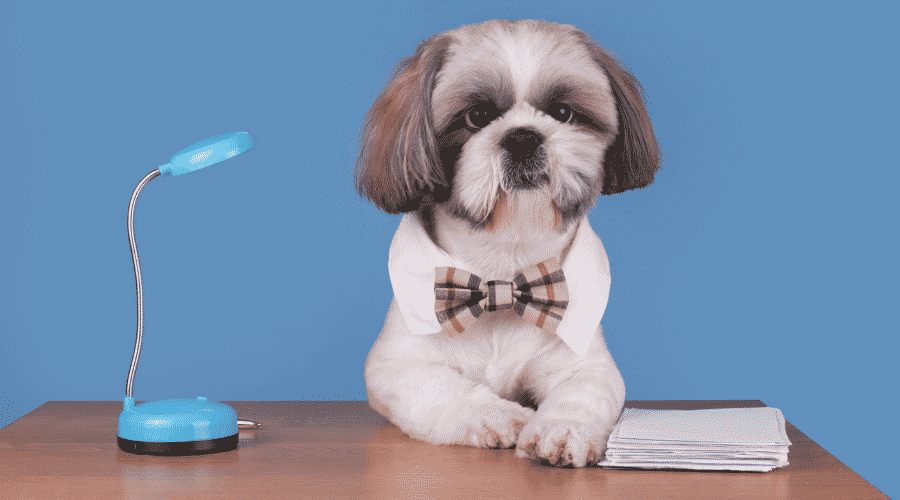
Do Shih Tzus Shed A Lot?
Compared to other breeds of dogs, the Shih Tzu sheds moderately. How much they shed varies seasonally, with the most noticeable shedding when they lose their summer and winter undercoats. Daily brushing minimizes how much hair ends up around the house.
Do I Need To Take My Shih Tzu To A Groomer?
You’ll probably want your Shih Tzu trimmed by a professional groomer unless you have experience with clippers. Their hair grows quickly, and clipping hair on their faces and feet requires a steady hand. If you don’t want to spend excessive time on your dog’s coat, consider getting your Shih Tzu a “puppy trim” by a professional groomer.
When Is It Time To Take My Shih Tzu To The Vet?
If your dog is shedding more than usual, inspect the skin beneath his coat. If you notice that his skin seems thick, greasy, scaly, red, or foul-smelling, schedule a consultation with your veterinarian.
Final Thoughts
If you fall in love with a Shih Tzu, his beautiful coat may be one of the reasons. If shedding is a concern, remember that even though they are not hypoallergenic dogs, the undercoat hairs they shed become trapped by their outer coat and can be brushed out by hand.
Care for your Shih Tzu’s coat with the proper tools and the occasional mild shampoo. Feed him a quality diet with omega-3 fatty acids to reduce inflammation and keep his skin healthy from the inside out.
